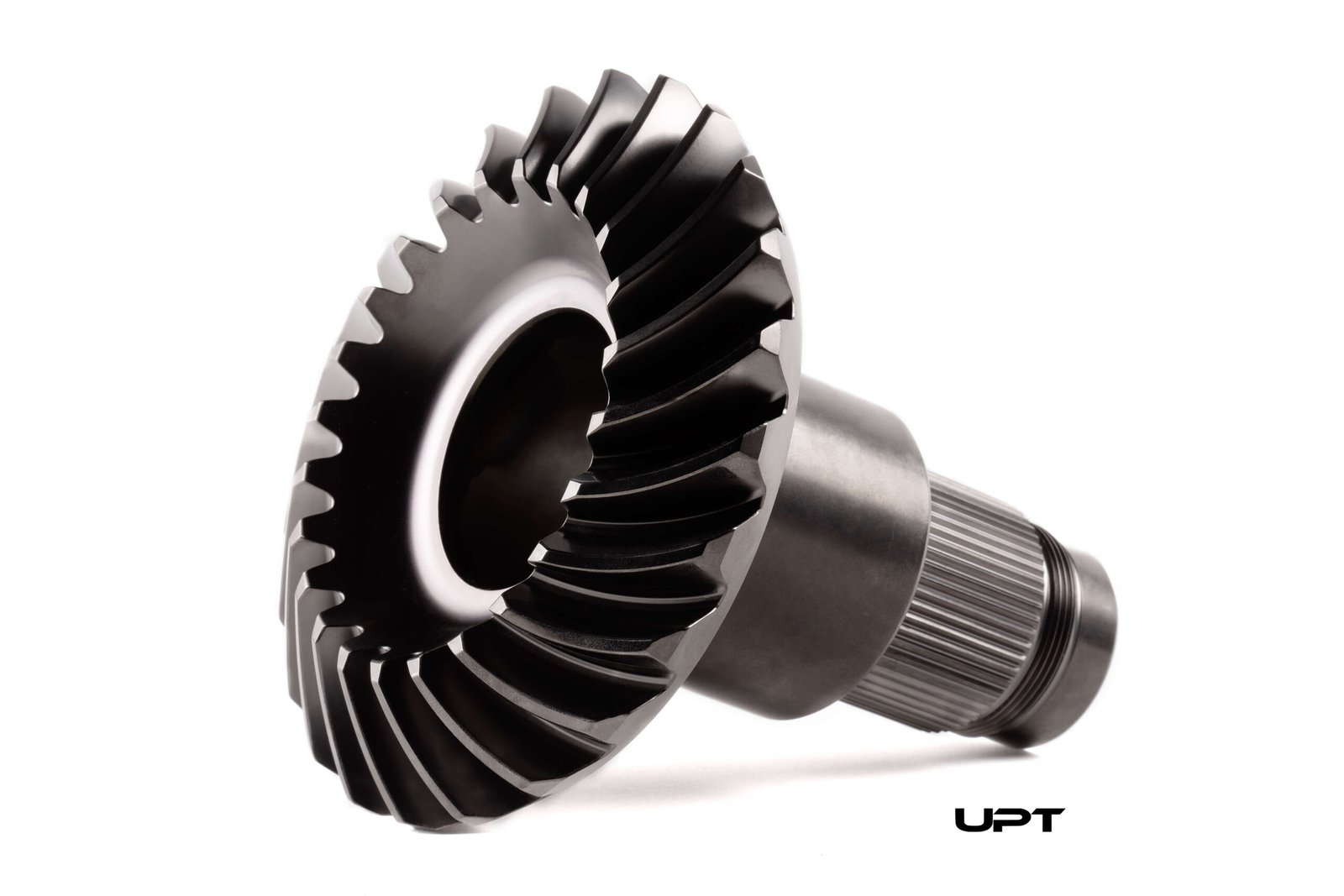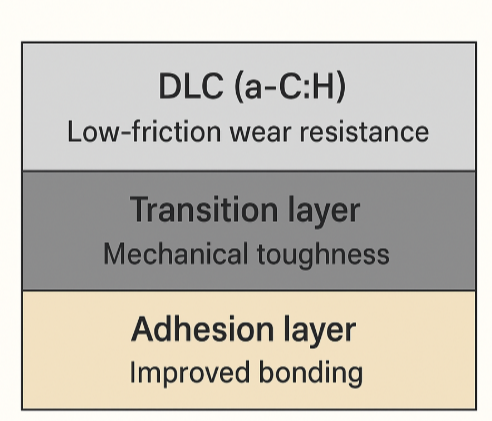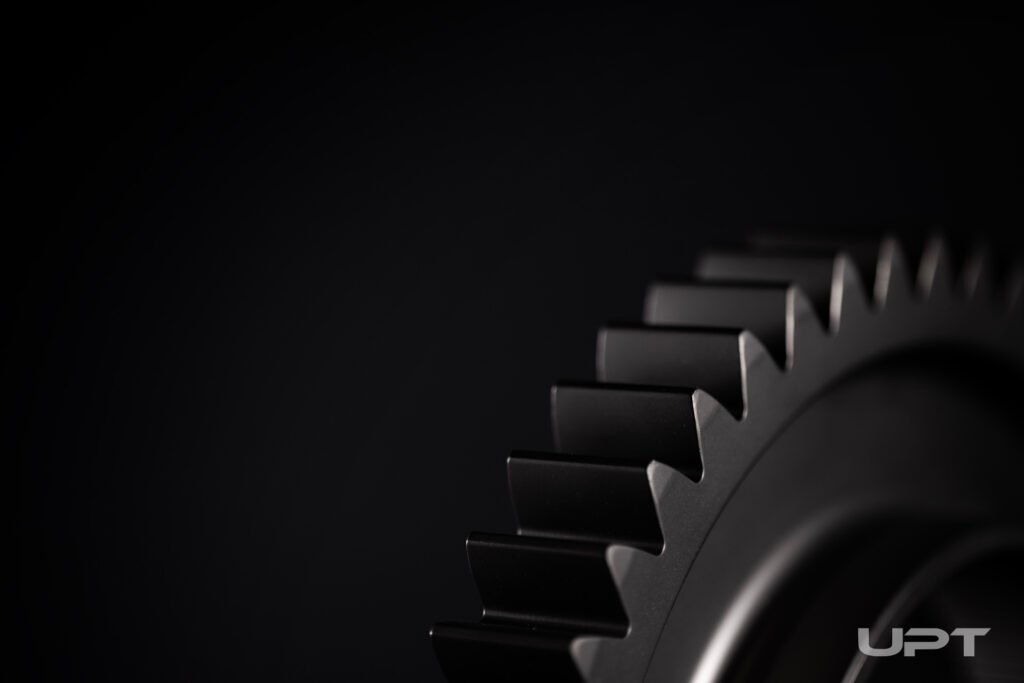
Figure 3: DLC-coated pinion.
Diamond-like carbon (DLC) coatings are rapidly becoming essential to high-performance gear systems across EVs, aerospace, and industrial sectors. This article explores their
tribological benefits, implementation strategies, and relevance to the Indian manufacturing ecosystem.
As gear systems evolve to meet higher power density and efficiency targets, especially under stricter environmental and maintenance constraints, thin-film coatings are no longer just an enhancement — they’re an engineering necessity. Whether applied in electric
vehicle (EV) drivetrains, aerospace actuation systems, industrial automation, or precision medical robotics, these coatings deliver precision-tuned surface properties that directly affect gear performance, reliability, and lifecycle cost.
Thin-film coatings are nanostructured surface treatments, typically 1 to 5 microns thick, deposited using advanced technologies like Physical Vapor Deposition (PVD) or Plasma- Enhanced Chemical Vapor Deposition (PECVD). These coatings are designed to modify surface properties, such as hardness, friction coefficient, chemical inertness, or thermal conductivity. DLC coatings are typically applied using hybrid PVD–PECVD methods, which allow dense, adherent layers to form on metals, polymers, or ceramics — without
significantly altering gear dimensions, clearances, or backlash.
In gear applications, thin films help suppress surface-originated failure modes like:
Modern gearing requirements are pushing boundaries:
Thin-film coatings respond to these demands by:
Among all coating technologies, Diamond-Like Carbon (DLC) stands out as the most versatile and high-performing for gear systems. DLCs are amorphous carbon films characterized by a mix of sp² (graphitic) and sp³ (diamond-like) bonds. Depending on deposition parameters and dopants (e.g., hydrogen, Si, Cr, W), they can be tailored for either extreme hardness, ultra-low friction, or chemical passivity [1][2].

| Property | Performance Benefit |
| Hardness (18–30 GPa) | Improves micropitting and scuffing resistance under high- contact loads |
| Friction Coefficient (<0.1) | Reduces sliding losses in hypoid and planetary stages, enhancing mechanical efficiency |
| Chemical Inertness | Resists lubricant breakdown, corrosion, and hydrogen embrittlement |
| Low Surface Energy | Suppresses debris adhesion and wear particle agglomeration |
| High Thermal Stability (300–500°C) | Suitable for high-speed gearboxes and hybrid-electric drivetrains |

Studies show that DLC-coated gear pairs can achieve 2–3× improvement in scuffing
resistance and 30% reduction in wear volume under starved lubrication conditions [6][7].
High RPM (10,000+), compact packaging, and oil-starved zones near magnetic coils make EV gears ideal candidates for DLC. Coated pinions and bearings reduce
losses, extend range, and improve thermal margins.
In automotive and truck differentials, DLC coatings on ground or lapped hypoid teeth eliminate the need for break-in, reduce lubricant degradation, and suppress NVH from transmission error. They also outperform traditional lapping for “lubed- for-life” systems [6].
Industrial gearboxes operate under demanding conditions: shock loads, high contact pressures, misalignment, and long-duration duty cycles in oil, gas, mining, pulp C paper, and wind energy environments. These systems often face lubricant starvation, high operating temperatures, and cyclic loading — conditions that
degrade traditional surface treatments and lead to early onset of micro-pitting or scuffing.
DLC coatings, especially those engineered with nanocomposite structures (e.g., adhesion + transition interlayers), serve as a robust tribological barrier that prevents metal-to-metal contact, even when lubrication is marginal. They also protect
against hydrogen embrittlement and corrosive degradation caused by residual moisture or additives in industrial oils.
Worm Gearboxes
Worm gears are uniquely challenging due to their inherent sliding contact mechanics, which result in high frictional losses and localized heating at the tooth interface. Traditional gear materials — even when hardened — are prone to wear, galling, and efficiency loss over time. DLC coatings drastically reduce friction
(coefficient of friction < 0.1) at the sliding interface, mitigating wear and improving overall mechanical efficiency. In fact, studies have shown that a 5–7% improvement in gearbox efficiency is achievable in DLC-coated bronze-steel worm pairs, with a corresponding reduction in oil temperature and extended
lubricant life [5].
DLC is particularly useful in sealed, maintenance-free worm gear drives, such as those used in conveyor systems, packaging machinery, actuators, and defense platforms where re-lubrication is impractical or prohibited.
Where lubrication must be minimal or biocompatible (e.g., prosthetics, flight actuation), DLC offers low stiction, zero particulate generation, and
biocompatibility, making it suitable for both cleanroom and medical-grade gears.
Implementing thin-film coatings in gear production requires a close collaboration between coating engineers, gear designers, and production teams. Key considerations include:
Gears made from low-alloy steels (e.g., 8620, 9310) often require a pre-treatment step such as Cr or CrN adhesion layers or surface activation via ion bombardment. For polymers, oxygen plasma or silane bonding primers may be needed.
typically used for better step coverage on complex geometries.
The future of gear coatings lies not just in making surfaces harder or slicker, but in making them smarter. Several developments are already reshaping how we think about gear surface engineering:
maintenance in defense, aerospace, or offshore energy systems [10].
incorporate nano-capsules that rupture to heal microcracks or replenish lubricant under overload conditions [2][8].
DLC coatings are gaining traction among Indian manufacturers striving for longer maintenance intervals, higher efficiency, and reduced lubricant costs. Many Indian gear manufacturers in sectors such as wind, steel, and agricultural equipment are increasingly adopting DLC-coated components to extend gear life, reduce wear, and minimize unplanned maintenance, aligning with national goals for energy efficiency and reliability improvements. With increasing momentum from initiatives like Make in India and government-backed productivity enhancements, thin-film coatings present a strategic pathway to globally competitive gear production.
These advances have been discussed at recent industry events such as IPTEX/GRINDEX India, and the upcoming 2025 edition is expected to spotlight live demonstrations of smart
coatings and tribosensors. Indian engineers exploring AGMA- and ISO-recognized standards will find DLC to be not only a performance upgrade but a sustainability enabler as well.
Q: Can DLC be applied to nitrided or case-hardened gears?
A: Yes, provided surface preparation is optimized. Surface activation and stress-relieving finishes like isotropic superfinishing are recommended to promote adhesion and prevent premature delamination.
A: No, DLC is compatible with most conventional industrial and automotive lubricants. However, pairing it with ester-based or additive-enhanced oils can improve durability and friction performance.
Figure 3: DLC-coated pinion.
Thin-film coatings, and DLC coatings in particular, are no longer optional enhancements for high-performance gears; they are strategic enablers of next-generation mechanical systems. From EV drivetrains to worm gearboxes and aerospace actuators, the benefits of lower friction, higher durability, and extended service life are well established. As gear designers and manufacturers face growing pressure to improve efficiency, reliability, and sustainability, thin-film surface engineering offers a proven path forward. With continued advancements in smart coating architectures and integrated condition monitoring, thin films will remain at the forefront of tribological innovation, transforming gears from passive power-transmitting elements into intelligent, high-efficiency components fit for the demands of tomorrow.
United Protective Technologies, LLC (UPT) is an industry leader in high-performance coatings. Founded in 2002, UPT has spent decades bringing solutions to the surface.
UPT’s thin-film coatings support multiple industries ranging from defense to automotive and firearms. For more information, please visit UPT’s website: www.upt-usa.com
Organization for Standardization, 2000.
pp. 4677–4694, 2010.
pp. 653–660, 2003.